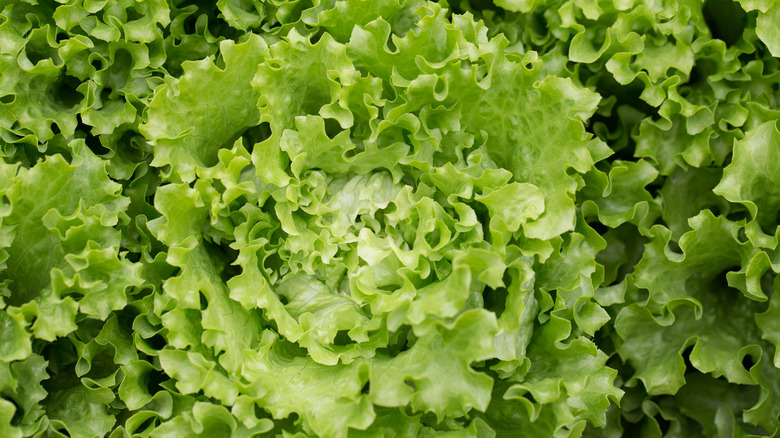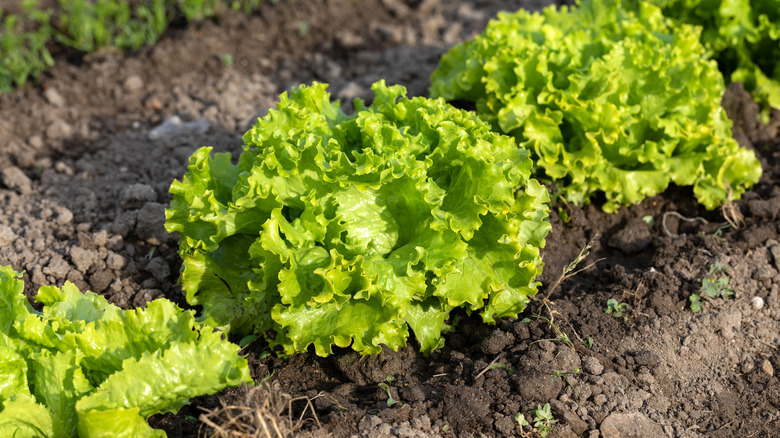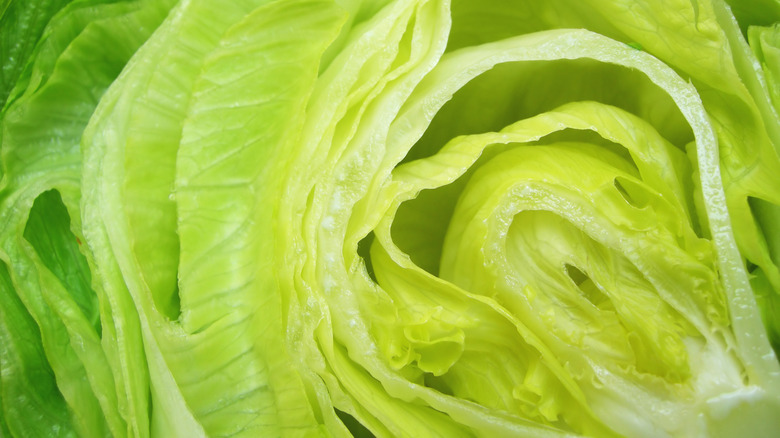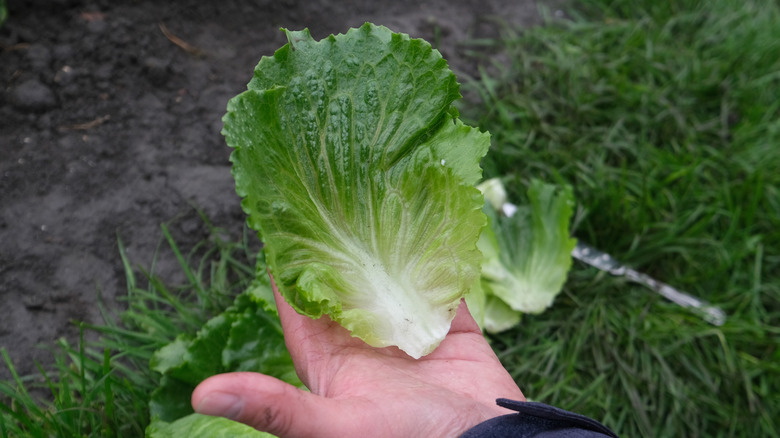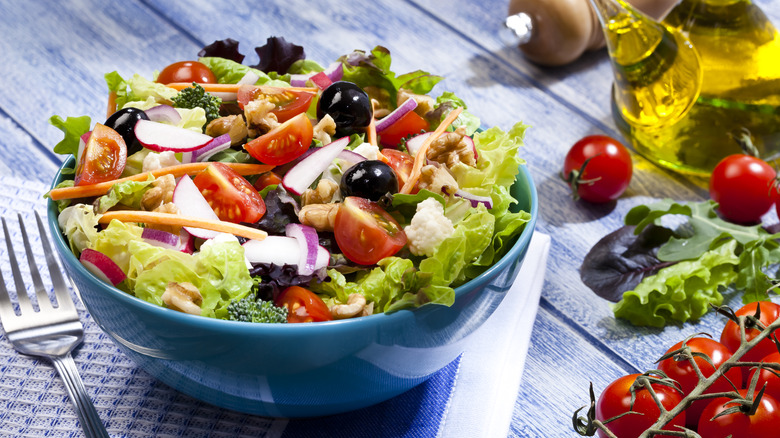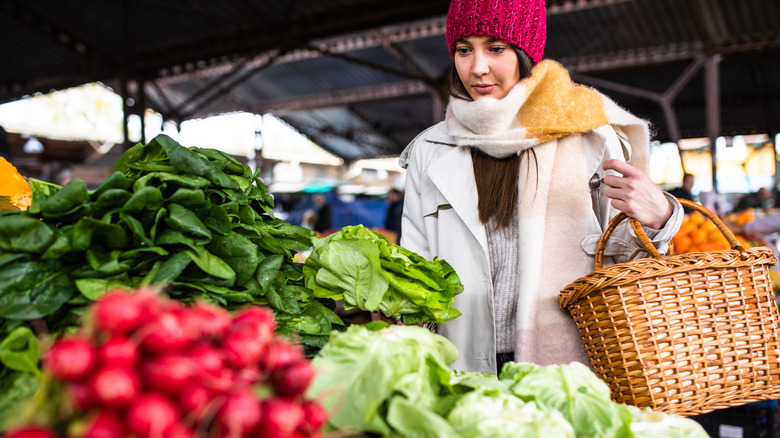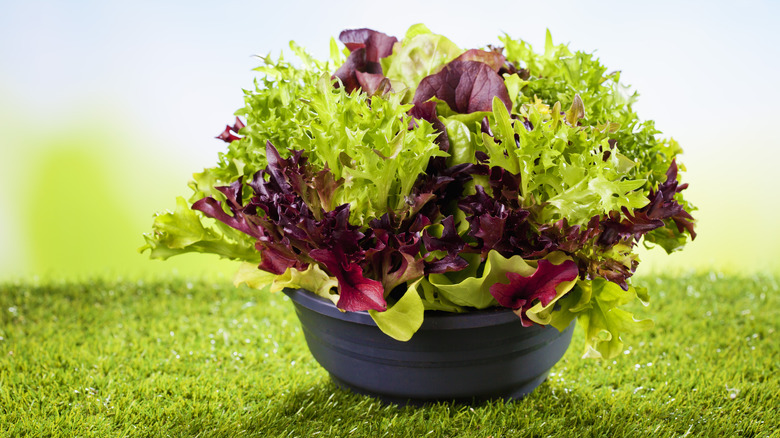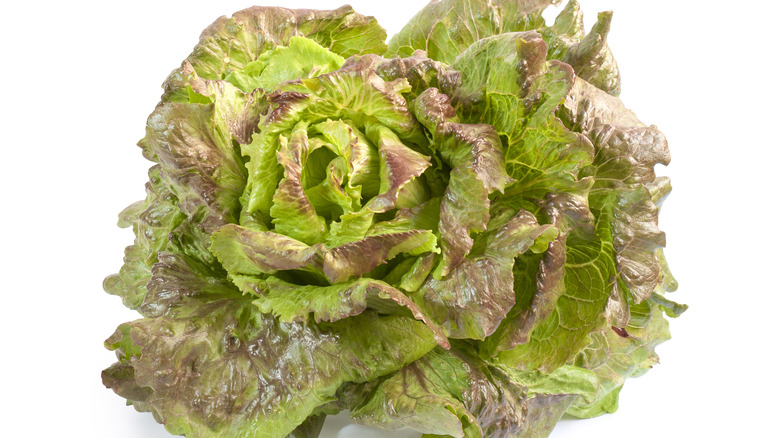What Is Batavia Lettuce And What Does It Taste Like?
If you're an iceberg lettuce lover but wish your leaves had a little more green and a tad more flavor, you may become a big fan of Batavia lettuce. If you don't recognize this variety, you may have heard it called by its nicknames — Summer Crisp or French lettuce — or possibly by its scientific name, Lactuca sativa. Or perhaps it just takes a backseat at grocery stores compared to much more well-known lettuce varieties like romaine, iceberg, and butterhead.
It's true that iceberg often overshadows Batavia lettuce, although this wasn't always the case. At the beginning of the 20th century, several types of Batavia lettuce were very popular. Iceberg lettuce was created as a descendant of Batavian cultivars, and by the 1930s, iceberg became one of the most beloved types of lettuce in the U.S. But that doesn't mean you should overlook the Batavia veggies — and there are a few compelling reasons why you may want to choose this type of lettuce over all others, even in the modern day.
What is Batavia lettuce?
As its name (and its French lettuce nickname) may suggest, Batavia lettuce originally came from Europe — specifically from France, although since Batavia is a previous name for Holland, it may have roots in the Netherlands as well. It made its way to the U.S. in 1885, where it became fashionable in the early 1900s. Although today it's one of the seven main lettuce groups (some of the others being romaine and butterhead), it was first created as a hybrid between red romaine (also known as Forellenschluss) and butterhead. Summer Crisp lettuce is part of the Asteraceae plant family, which boasts a whole host of plants including artichokes, safflower, and stevia.
A Batavia lettuce head is round and dense, with wavy leaves that can be green or red. There are tons of varieties, so you may see versions that are light green, dark green, purple-red, and more. While its flavor and texture have qualities that make it stand out, Batavia is particularly favorable among farmers and home gardeners because it's highly heat-resistant while still being fairly tolerant of frost.
Batavia lettuce vs. iceberg lettuce
At first glance, it's easy to mistake Batavia and iceberg lettuce for each other. The two are both part of the crisphead family, which is characterized by round heads and dense leaves. And as we mentioned, iceberg is actually a child plant of Batavia. It was developed by Atlee Burpee & Company in 1894 (who is responsible for breeding many other new types of carrots, celery, and sweet peppers, among other veggies and fruits), and the variety was created specifically to have long-term crispiness. Iceberg today still maintains a reputation for being the ultimate crispy lettuce variety and is renowned for its ability to successfully grow in cool temperatures.
So what's the difference between iceberg and Batavia lettuce? Firstly, the leaves are greener (or redder) and wavier in the latter, while iceberg only ranges from white to light green in color — and the Batavia lettuce leaves contain more flavor than the ones in a head of iceberg. Plus, Batavia heads tend to be smaller with slightly looser leaves, while iceberg's are more densely packed. Unsurprisingly, Batavia also isn't quite as crunchy or juicy as its crisphead brethren — and due to its popularity (and origins) in Europe, you're more likely to find it across the pond, while the American-bred iceberg is widely available in most U.S. grocery stores.
What does Batavia lettuce taste like?
Though not as crisp and hearty as iceberg, Batavia lettuce leaves can still hold their own once plucked off the head and can still be used as the base for lettuce wraps. Unlike smoother varieties like butterhead, the wavy Batavia leaves have a little more texture. Their flavor is mildly sweet and juicy without any bitterness, while the heart of their lettuce head has a somewhat nutty taste.
If you find romaine or endive to be too bitter, you may want to go with Batavia lettuce instead. This variety may also be your go-to if your recipe requires something a little sturdier than the more tender butter or Boston lettuce leaves. But if you want something smaller and more delicate — perhaps as a pizza topping, or if you're looking to sauté your veggies for a side dish — you may want to opt for arugula, spinach, or watercress. They're not technically types of lettuce, but they'll satisfy your leafy green quota in a way that the larger Batavia lettuce leaves can't.
How to cook with Batavia lettuce
If you buy a head of Batavia lettuce, you'll have your pick of ways to use it. The big, crispy leaves are perfect for holding ingredients for lettuce wraps, but they're also the perfect size for placing in the middle of a sandwich or on a burger. You'll get a nice crunch and a mild flavor that won't turn your sandwich into a bitter dish. You can also use these leaves as the base for a chicken or tuna salad, and they're large enough that you can roll them up into a wrap (such as a chicken bacon ranch wrap).
Of course, Batavia leaves are perfect in salads, where you'll get to taste all that fresh, yummy crispiness. You can leave them in as is or chop or rip them up to create more bite-sized pieces. Their mildly sweet flavor makes them the perfect pairing to a variety of cheeses, nuts, seeds, and other veggies — because again, you'll be able to taste the leaves, but they won't overpower the flavor of other ingredients. However, you can also shred them and use them to top tacos, nachos, burrito bowls, or tostadas. You likely won't want to sauté Batavia lettuce as doing so will cause it to lose all that signature crispiness, but you can grill it in big chunks to give it a nice charred flavor.
Where to buy Batavia lettuce
Although Batavia lettuce takes a backseat to the super-popular iceberg in the States, you may still be able to find it in many major grocery stores here, such as Albertsons. Look out for the lettuce under its other names, French and Summer Crisp, or for the names of its different varieties. However, you may have the best luck at farmers markets when Batavia lettuce is in season, which is essentially year-round except for summer (although some types grow in the hotter months, too). If you are able to shop for these lettuce heads, look for a bright color — whether red or green — and a juicy, crisp texture. Once you take the lettuce home, it should last in your fridge for about four days.
If you can't track down the full-grown leaves themselves, the seeds are readily available all over the internet for you to put your green thumb to use. You can even get them at big-box stores like Walmart, although you'll also find them at smaller retailers such as My Seeds.Co, Johnny's Selected Seeds, and Isla's Garden Seeds. Of course, you'll want to start growing long before you need Batavia lettuce for your cooking: The leaves typically take about 59 days to mature, and they thrive in temperatures between 60 and 65 degrees Fahrenheit.
Nutritional information about Batavia lettuce
In general, lettuce is a highly nutritious food, and the Batavia variety is no exception. At 95% water, it's a hydrating veggie, and it's low in carbs, fat, and protein. However, you'll find plenty of fiber in this lettuce (2.1 grams per 100 grams of lettuce), and it's a good source of manganese, potassium, vitamin B9, vitamin K1, and vitamin A.
Vitamin B9, also known as folate or folic acid, can help your cells grow and function properly, allow red blood cells to mature, and even help repair your DNA, according to Healthline. Vitamin K1 (aka vitamin K), on the other hand, assists with blood clotting, helps bone growth, and may help prevent heart disease. And vitamin A — also known as retinoic acid — is an antioxidant that can help your reproductive system, immune system, cell communication, and overall growth, per the U.S. Department of Health & Human Services.
Are there any side effects of eating lettuce in general? Yes, but it's not likely you'll experience them. According to Livestrong, consuming too much of the beta-carotene can result in your skin taking on a yellowish hue, but you'd have to eat a ton of it for this to occur — you're much more likely to experience this from consuming veggies higher in beta-carotene, like carrots.
Varieties of Batavia lettuce
There are a plethora of different Batavia lettuce varieties, as evidenced by the range of colors you can find in these leaves. Perhaps the most well-known is the Nevada type, which is a sunny green hue and grows primarily in the spring and summer. This variety is practically a twin of the Concept type, which is the child of Batavia and romaine lettuce and is therefore less bitter than typical romaine leaves. Concept plants are highly tolerant of hot, cool, wet, and windy weather, making them a favorite of home gardens, and they thrive from April through August.
If you're looking for a darker color in your veggies, however, you may want to try the Cherokee or Cardinale varieties of Batavia lettuce. They're both a burgundy shade (although Cherokee is darker than Cardinale), but the Cardinale veggies can have a green center. These two have slightly less sweetness than the greener types, and you may even get notes of nuttiness in Cherokee leaves. If you want gorgeous green leaves with just a tinge of wine coloring, go for the Sierra variety, which likes to grow in cooler temperatures. And you don't have to stop there — feel free to explore the many other types of Batavia lettuce for your favorite color and flavor nuances, including Loma, Muir, Mottistone, and Anuenue.
